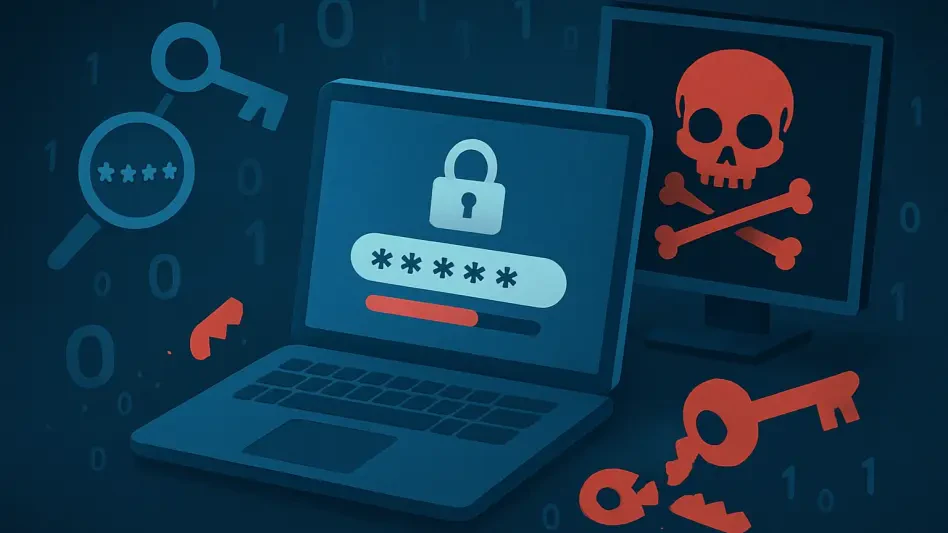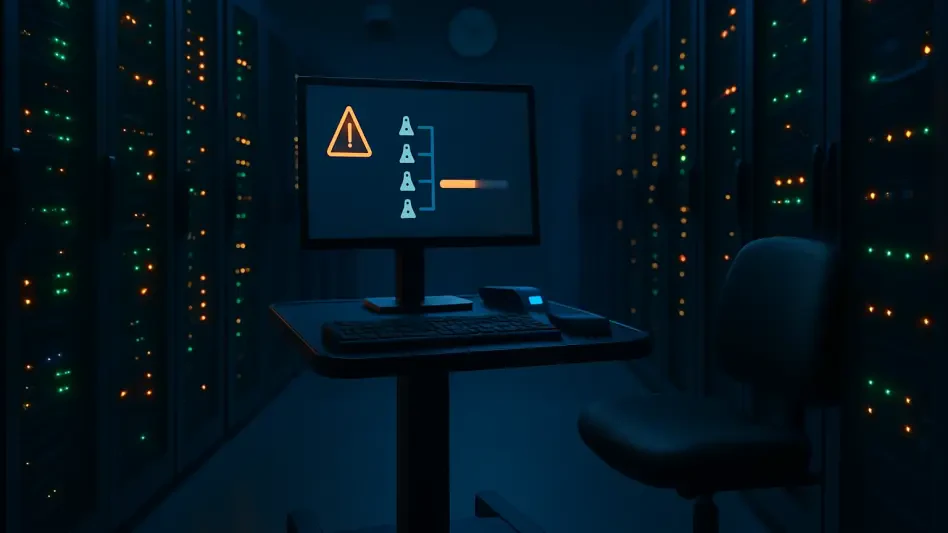In the relentless cat-and-mouse game of cybersecurity, the emergence of cutting-edge hardware and artificial intelligence (AI) has tipped the scales toward cybercriminals, putting even the most trusted password protection methods under severe strain. Bcrypt, long considered a gold standard for securing passwords through hashing, is now facing unprecedented challenges as brute force attacks become faster and more efficient. With technology advancing at a breakneck pace, the tools once reserved for high-budget operations are increasingly accessible to malicious actors, shrinking the window of safety for digital credentials.
This exploration uncovers the intricate dynamics of password security in an era dominated by powerful graphics processing units (GPUs) and AI-driven hacking techniques. Drawing on expert insights and recent studies, it sheds light on how Bcrypt holds up against modern threats and why human behavior remains a critical vulnerability. The stakes are higher than ever, as the balance between innovation and exploitation continues to shift, demanding a reevaluation of how passwords are created and protected.
As new hardware generations roll out, paired with intelligent algorithms, the time required to crack passwords has plummeted from days to mere hours or even minutes. This alarming trend underscores a harsh reality: relying solely on traditional defenses is no longer sufficient. Both individuals and organizations must adapt to this evolving landscape, where the intersection of technology and user habits dictates the strength of digital barriers.
The Forces Behind Faster Hacking
Cutting-Edge Hardware Powers Attacks
The surge in computing power, exemplified by innovations like Nvidia’s RTX 5090, has dramatically altered the cybersecurity battlefield. These high-performance GPUs, once out of reach for most, are now more affordable, enabling cybercriminals to execute brute force attacks with startling efficiency. A study by Specops Software demonstrated that newer hardware can crack Bcrypt hashes approximately 65% faster than older models like the RTX 4090. This leap in speed means that passwords which might have taken significant time to break a few years ago are now vulnerable in a fraction of that duration, highlighting how technological advancements are a double-edged sword in the fight against cybercrime.
Beyond raw speed, the accessibility of such hardware lowers the entry barrier for malicious actors. What was once the domain of well-funded groups or state-sponsored entities is now within reach of smaller-scale hackers. This democratization of powerful tools amplifies the threat, as more individuals can launch sophisticated attacks without needing extensive resources. The result is a growing wave of brute force attempts targeting even well-secured systems, putting pressure on algorithms like Bcrypt to withstand an onslaught of increasingly capable adversaries.
AI as a Game-Changer in Cracking
Artificial intelligence adds another layer of potency to the hacker’s arsenal by refining the art of password guessing. Unlike traditional brute force methods that systematically try every possible combination, AI-driven approaches analyze patterns and prioritize likely passwords, slashing the time needed to breach weaker credentials. When combined with state-of-the-art hardware, these algorithms turn a once-tedious process into a streamlined operation, making short or predictable passwords particularly susceptible to rapid compromise.
The synergy between AI and modern GPUs creates a formidable challenge for cybersecurity defenses. By leveraging machine learning to study vast datasets of leaked credentials, attackers can fine-tune their strategies, focusing on common user habits and predictable character combinations. This intelligent approach means that even passwords protected by robust hashing like Bcrypt face heightened risks if they lack sufficient length or complexity. As AI continues to evolve, its ability to outsmart static security measures grows, underscoring the need for dynamic and adaptive countermeasures.
Bcrypt’s Strengths and Struggles
A Robust Defense Under Siege
Bcrypt has earned its reputation as a formidable barrier against password cracking since its inception over two decades ago, thanks to its innovative design. By incorporating a unique “salt”—a random string added to each hash—it ensures that identical passwords produce different outputs, thwarting precomputed attack methods like rainbow tables. Additionally, a configurable cost factor increases the computational effort required for hashing, deliberately slowing down both legitimate processes and malicious attempts. This makes Bcrypt far more resilient compared to outdated algorithms like MD5, positioning it as a trusted choice for securing sensitive data.
However, resilience does not equate to invincibility, and Bcrypt’s effectiveness hinges on the passwords it protects. While its design slows down attackers, the algorithm cannot compensate for inherently weak user choices. The computational burden imposed by the cost factor remains a hurdle, but as hardware capabilities soar, this barrier is steadily eroding. For organizations and developers relying on Bcrypt, understanding these limitations is crucial to implementing complementary safeguards that address the gaps left by technology alone.
Vulnerabilities Exposed by Modern Tools
Despite Bcrypt’s strengths, recent advancements in hardware reveal troubling cracks in its armor, particularly for simpler passwords. Testing by Specops Software showed that modern GPUs can instantly crack Bcrypt-hashed passwords of 4 to 6 characters, even when they include a mix of numbers, uppercase, and lowercase letters. This is a significant shift from older hardware, which struggled with similar tasks, indicating that the protective window offered by Bcrypt is narrowing as computing power surges forward with each new generation of technology.
The implications of these findings are stark for users and systems relying on shorter or less complex passwords. While Bcrypt’s design still offers substantial resistance to brute force attacks on longer, diverse credentials, the reality is that many individuals opt for convenience over security. This mismatch between algorithmic strength and user behavior creates a perfect storm for cybercriminals, who can exploit these weaknesses with tools that are both powerful and increasingly accessible. The urgency to educate users on password complexity has never been greater.
Human Factors Undermining Security
The Perils of Password Fatigue
A persistent challenge in cybersecurity lies not in the technology itself, but in the human tendencies that undermine it. Password fatigue, the frustration of juggling numerous complex credentials across multiple platforms, often drives users to choose simplicity over safety. Common choices like “password123” or sequential numbers remain prevalent, even in professional environments, creating low-hanging fruit for attackers. Even with robust hashing like Bcrypt in place, such predictable selections offer little resistance to determined hackers wielding modern tools.
This behavioral flaw is compounded by the sheer volume of accounts most individuals manage today, from personal emails to workplace systems. The temptation to reuse passwords or opt for easily memorable combinations grows with each additional login requirement. Unfortunately, this practice directly contradicts the principles of secure credential management, leaving systems vulnerable despite the presence of advanced defenses. Addressing this issue requires not just technological solutions, but a cultural shift toward prioritizing security over convenience.
Risks of Exposed Credentials
Compromised passwords represent an even more immediate danger, as they can be exploited almost instantly regardless of the hashing algorithm in use. Once a credential is exposed through data breaches, infostealers, or reuse across accounts, it becomes a liability that bypasses even Bcrypt’s protections. Attackers maintain vast databases of leaked passwords, ready to test against any system, making the reuse of even a single credential a catastrophic risk for both individuals and organizations.
The speed at which exposed passwords can be weaponized underscores a critical lesson: prevention trumps reaction. No amount of computational complexity in hashing can safeguard a password that has already been revealed to the world. Continuous monitoring for breaches and enforcing strict policies against reuse are essential steps to mitigate this threat. As cybercriminal tactics evolve alongside technology, maintaining vigilance over credential integrity becomes a cornerstone of any effective security strategy, ensuring that known vulnerabilities are addressed before they can be exploited.
Strategies to Bolster Defenses
Empowering Users with Strong Practices
To counter the escalating threat of password cracking, adopting robust personal habits is paramount for every user. Experts recommend crafting passwords of at least 18 characters, incorporating a diverse mix of uppercase and lowercase letters, numbers, and special symbols to maximize resistance against brute force attacks. An alternative approach involves using passphrases—longer strings of words that are easier to remember yet harder to guess—enhanced by deliberate misspellings to add an extra layer of unpredictability.
This focus on length and complexity serves a practical purpose: it exponentially increases the time and resources required for an attacker to succeed. A password exceeding 18 characters, even if partially predictable, can render most brute force attempts impractical within a reasonable timeframe. By prioritizing these strategies, users can significantly elevate their defenses, ensuring that even the most advanced hardware and AI tools struggle to breach their accounts. Education on these practices remains a vital tool in closing the gap between technological capability and personal responsibility.
Organizational Policies for Robust Protection
For businesses, safeguarding against password vulnerabilities demands a proactive and structured approach beyond individual efforts. Implementing custom dictionaries to block predictable or company-related terms in passwords is a critical measure to eliminate common weaknesses. Additionally, enforcing strict rules against reuse across accounts and systems helps prevent a single breach from cascading into widespread compromise, fortifying the overall security posture.
Regular audits and mandatory employee training further strengthen these defenses by addressing the human element at the core of many breaches. By fostering a culture of awareness, organizations can reduce the likelihood of password fatigue leading to poor choices. Policies should also integrate tools to detect and replace compromised credentials swiftly, minimizing exposure windows. As cyber threats grow more sophisticated, such multi-layered strategies ensure that businesses are not only reacting to risks but actively staying ahead of them, blending policy with technology for maximum impact.
Preventing Instant Exploitation
The reality of instantaneous password cracking for known credentials serves as a sobering reminder that uniqueness is non-negotiable. Using distinct passwords for every account, coupled with monitoring services to identify leaks, can prevent attackers from capitalizing on exposed data. This proactive stance ensures that even if one credential is compromised, the damage remains contained, preserving the integrity of other systems and accounts.
Moreover, integrating solutions that alert users to potential breaches allows for rapid response, such as immediate password changes before exploitation occurs. This vigilance is especially crucial in an era where vast repositories of stolen credentials are readily available to hackers. By combining unique password creation with real-time threat detection, the risk of instant cracking diminishes significantly. As hardware and AI continue to empower attackers, these preventative measures stand as the first line of defense, ensuring that security keeps pace with ever-evolving challenges.








